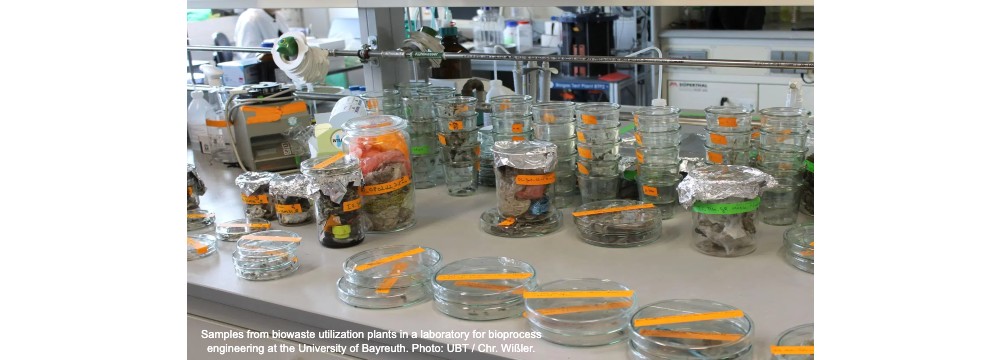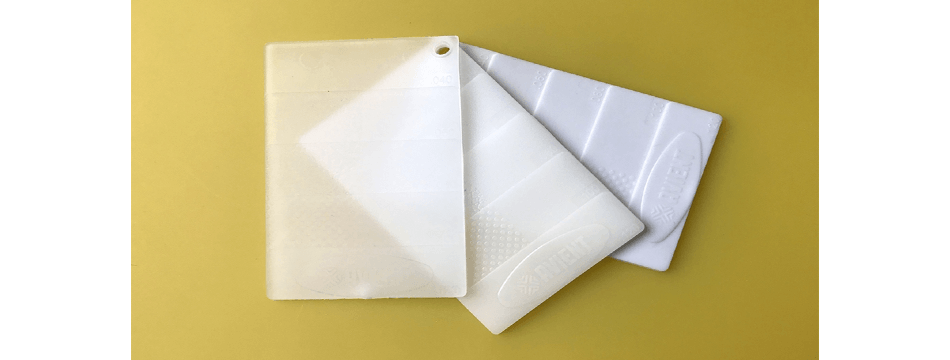New study from Bayreuth: Fertilisers from composting plants contain large quantities of biodegradable plastics

Composting plants process biowaste into finished compost, which ends up as fertiliser in the soils of fields and gardens. A study by the University of Bayreuth shows that finished compost from composting plants in Germany contains a large number of biodegradable plastic particles. Applicable legal and certification standards are not violated by the sizes and quantities of the particles detected. However, the data published in "Scientific Reports" call into question the contribution of these standards to effective environmental protection. They draw into question whether biodegradable plastics are suitable for replacing conventional plastics in environmentally and nutritionally sensitive areas.
The new study is the result of close interdisciplinary cooperation in the SFB 1357 "Microplastics" Collaborative Research Centre at the University of Bayreuth. The Ministry for the Environment, Climate Protection and the Energy Sector of the State of Baden-Württemberg funded the research work. This is the first scientific study to systematically examine commercially available compost for biodegradable plastic particles. The Bayreuth scientists worked together with four municipal biowaste recycling plants in Baden-Württemberg. These plants use established technical procedures to process biowaste in a two-stage process, the microbial production of biogas being followed by the conversion of the organic residual material into high-quality compost.
In the finished compost from the four plants, the Bayreuth researchers discovered a significant number of biodegradable microplastic particles that have a size of less than one millimetre. Together, these particles make up 0.43 percent of the compost's dry weight. The German Fertiliser Ordinance (DüMV) does require that the proportion of biodegradable plastic in high-quality compost be a maximum of only 0.1 per cent of the dry weight. However, this limit refers only to microplastic particles larger than two millimetres.
"The legally defined limit value for the proportion of biodegradable microplastics should in future also include much smaller particles in order to significantly reduce the pollution of agricultural land. This seems particularly necessary because finished compost contains a very large number of particles smaller than two millimetres. As our study shows, in many cases these particles have properties that can significantly delay their biological degradation by microorganisms," says the head of the study, Prof. Dr. Ruth Freitag, Chair of Bioprocess Engineering. "The longer microplastic particles remain in the soil, the greater the danger that they will be taken up by soil organisms and thus enter the food chain," warns the Bayreuth bioscientist.
The European certification standard EN 13432 for compostable and therefore biodegradable material is also not very effective in the context of the new study. According to this standard, plastics are biodegradable if 90 per cent of them have decomposed into particles smaller than two millimetres in less than twelve weeks. "However, in composting plants that correspond to the current state of the art, composting takes place in shorter periods of time. It is quite possible that this is why we still found residues of biodegradable material in the finished composts. Unfortunately, the certification of such a product as compostable and thus biodegradable says nothing about its further behaviour in the environment. On the contrary, there are research papers from other working groups at the University of Bayreuth that prove that such materials remain in the environment for years," says Thomas Steiner M.Sc., one of the first authors of the study and a doctoral student at the Bioprocess Engineering research group at the University of Bayreuth.
The study, published in Scientific Reports, also covers biodegradable plastic particles contained in liquid fertilisers. These fertilisers are produced by anaerobic treatment of the biowaste delivered to three of the four municipal plants that made their biocompost available for the scientific analyses. Several thousand plastic particles per litre were found in the liquid fertilisers, these particles having a diameter of less than half a millimetre.
In both the finished compost and the liquid fertiliser, PLA (polylactide acid, also called polylactic acid) and PBAT (polybutylene adipate terephthalate) are the most common types of plastic. Numerous indications point to the fact that they largely originate from commercially available biodegradable rubbish bags that have been disposed of in the bio-waste bins of private households together with the bio-waste they contain. "Many private households in Germany nowadays readily use commercially available biodegradable waste bags and biodegradable food films. Nevertheless, our research results raise the question of whether these plastic products should continue to be disposed of as biowaste and applied in fields and gardens to the same extent as to date. With the current state of research, we cannot rule out the decomposition products remaining in the soil for a long time and having harmful effects. It has not been proven that they are rapidly converted into carbon dioxide, water, and biomass by microorganisms in all cases," says Prof. Ruth Freitag.
Publication:
Thomas Steiner, Yuanhu Zhang, Julia N. Möller, Seema Agarwal, Martin G. J. Löder, Andreas Greiner, Christian Laforsch, Ruth Freitag: Municipal biowaste treatment plants contribute to the contamination of the environment with residues of biodegradable plastics with putative higher persistence potential. Scientific Reports (2022), DOI: https://doi.org/10.1038/s41598-022-12912-z
The new study is the result of close interdisciplinary cooperation in the SFB 1357 "Microplastics" Collaborative Research Centre at the University of Bayreuth. The Ministry for the Environment, Climate Protection and the Energy Sector of the State of Baden-Württemberg funded the research work. This is the first scientific study to systematically examine commercially available compost for biodegradable plastic particles. The Bayreuth scientists worked together with four municipal biowaste recycling plants in Baden-Württemberg. These plants use established technical procedures to process biowaste in a two-stage process, the microbial production of biogas being followed by the conversion of the organic residual material into high-quality compost.
In the finished compost from the four plants, the Bayreuth researchers discovered a significant number of biodegradable microplastic particles that have a size of less than one millimetre. Together, these particles make up 0.43 percent of the compost's dry weight. The German Fertiliser Ordinance (DüMV) does require that the proportion of biodegradable plastic in high-quality compost be a maximum of only 0.1 per cent of the dry weight. However, this limit refers only to microplastic particles larger than two millimetres.
"The legally defined limit value for the proportion of biodegradable microplastics should in future also include much smaller particles in order to significantly reduce the pollution of agricultural land. This seems particularly necessary because finished compost contains a very large number of particles smaller than two millimetres. As our study shows, in many cases these particles have properties that can significantly delay their biological degradation by microorganisms," says the head of the study, Prof. Dr. Ruth Freitag, Chair of Bioprocess Engineering. "The longer microplastic particles remain in the soil, the greater the danger that they will be taken up by soil organisms and thus enter the food chain," warns the Bayreuth bioscientist.
The European certification standard EN 13432 for compostable and therefore biodegradable material is also not very effective in the context of the new study. According to this standard, plastics are biodegradable if 90 per cent of them have decomposed into particles smaller than two millimetres in less than twelve weeks. "However, in composting plants that correspond to the current state of the art, composting takes place in shorter periods of time. It is quite possible that this is why we still found residues of biodegradable material in the finished composts. Unfortunately, the certification of such a product as compostable and thus biodegradable says nothing about its further behaviour in the environment. On the contrary, there are research papers from other working groups at the University of Bayreuth that prove that such materials remain in the environment for years," says Thomas Steiner M.Sc., one of the first authors of the study and a doctoral student at the Bioprocess Engineering research group at the University of Bayreuth.
The study, published in Scientific Reports, also covers biodegradable plastic particles contained in liquid fertilisers. These fertilisers are produced by anaerobic treatment of the biowaste delivered to three of the four municipal plants that made their biocompost available for the scientific analyses. Several thousand plastic particles per litre were found in the liquid fertilisers, these particles having a diameter of less than half a millimetre.
In both the finished compost and the liquid fertiliser, PLA (polylactide acid, also called polylactic acid) and PBAT (polybutylene adipate terephthalate) are the most common types of plastic. Numerous indications point to the fact that they largely originate from commercially available biodegradable rubbish bags that have been disposed of in the bio-waste bins of private households together with the bio-waste they contain. "Many private households in Germany nowadays readily use commercially available biodegradable waste bags and biodegradable food films. Nevertheless, our research results raise the question of whether these plastic products should continue to be disposed of as biowaste and applied in fields and gardens to the same extent as to date. With the current state of research, we cannot rule out the decomposition products remaining in the soil for a long time and having harmful effects. It has not been proven that they are rapidly converted into carbon dioxide, water, and biomass by microorganisms in all cases," says Prof. Ruth Freitag.
Publication:
Thomas Steiner, Yuanhu Zhang, Julia N. Möller, Seema Agarwal, Martin G. J. Löder, Andreas Greiner, Christian Laforsch, Ruth Freitag: Municipal biowaste treatment plants contribute to the contamination of the environment with residues of biodegradable plastics with putative higher persistence potential. Scientific Reports (2022), DOI: https://doi.org/10.1038/s41598-022-12912-z






